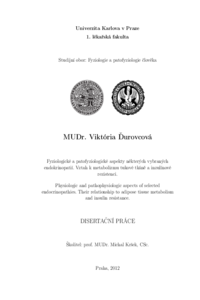Fyziologické a patofyziologické aspekty některých vybraných endokrinopatií. Vztah k metabolizmu tukové tkáně a inzulínové rezistenci
Physiologic and pathophysiologic aspects of selected endocrinopathies. Their relationship to adipose tissue matebolism and insulin resistance
dizertační práce (OBHÁJENO)

Zobrazit/
Trvalý odkaz
http://hdl.handle.net/20.500.11956/57325Identifikátory
SIS: 126472
Katalog UK: 990015570250106986
Kolekce
- Kvalifikační práce [4870]
Autor
Vedoucí práce
Oponent práce
Saudek, František
Štich, Vladimír
Fakulta / součást
1. lékařská fakulta
Obor
-
Katedra / ústav / klinika
III. interní klinika - klinika endokrinologie a metabolismu 1. LF UK a VFN
Datum obhajoby
15. 11. 2012
Nakladatel
Univerzita Karlova, 1. lékařská fakultaJazyk
Čeština
Známka
Prospěl/a
Klíčová slova (česky)
obezita, inzulínová rezistence, kortizol, růstový hormon, fibroblastový růstový faktor 21 a 19, adipocytární mastné kyseliny vážící protein, mitochondriálni dysfunkceKlíčová slova (anglicky)
obesity, insulin resistance, cortisol, growth hormone, fibroblast growth factors 21 and 19, adipocyte fatty acid binding protein, mitochondrial dysfunctionPatogeneze inzulínové rezistence není dosud zcela objasněna a podílí se na ní řada faktorů. Velmi významná úloha se v poslední době přisuzuje změnám v endokrinní a parakrinní aktivitě tukové tkáně a jejímu vztahu k mitochondriální dysfunkci. Cílem první části práce bylo charakterizovat úlohu tukové tkáně a jejích pro- duktů v patogenezi inzulínové rezistence u jednotlivých zkoumaných skupin paci- entů, tj. u pacientů s Cushingovým syndromem, akromegalií a prostou obezitou. Zaměřili jsme se na výzkum tří důležitých regulátorů metabolické homeostázy, a to fibroblastových růstových faktorů 21 a 19 (FGF-21 a FGF-19) a adipocytární mastné kyseliny vážícího proteinu (FABP-4). Naše práce prokázala, že inzulínová rezistence jak u prosté obezity, tak i u obe- zity doprovázející hyperkortizolizmus je spojená s významně zvýšenými cirku- lujícími hladinami FGF-21 a FABP-4 oproti zdravým kontrolám. Koncentrace obou látek byly srovnatelné mezi pacienty s Cushingovým syndromem a pros- tou obezitou. Tento fakt spolu s chybějící korelací mezi hladinami FGF-21, resp. FABP-4 a hladinami plazmatického kortizolu naznačují, že se jedná nejspíš o vliv obezity a jejích metabolických důsledků, nežli o samotné přímé působení hyper- kortizolémie na produkci FGF-21 a FABP-4. U plazmatických hladin FGF-19 jsme nenašli žádné...
The pathogenesis of insulin resistance is a complex and still intensively studied issue. Endocrine and paracrine activity of the adipose tissue together with mi- tochondrial dysfunction are the most discussed potential factors included in the development of insulin resistance. In the first part of our study we examined the involvement of the adipose tissue and its secretory products in the etiopathogenesis of insulin resistance in patients with Cushing's syndrome, acromegaly and simple obesity. We focused on three important regulators of metabolic homeostasis - fibroblast growth factors 21 and 19 (FGF-21 and FGF-19) and adipocyte fatty acid binding protein (FABP-4). We found significantly elevated circulating levels of FGF-21 and FABP-4 ac- companying insulin resistance in both patients with simple obesity and patients with obesity connected to Cushing's syndrome, as compared to healthy controls. The concentrations of both substances were comparable between hypercortisolic and obese patients. This finding together with the absence of correlation be- tween the levels of FGF-21 resp. FABP-4 and cortisol suggest that the reason for elevation of their concentrations is obesity and its metabolic consequences themselves rather then the effect of hypercortisolism on FGF-21 and FABP-4 production. We found no...
